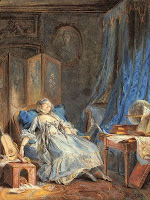Evidence that plain – especially brown – woollen or linen stays were worn by the wealthier women:
(please note – I wrote this maybe 5 years ago – and it is just a friendly discourse on stays – more research has been ongoing since I wrote it but I have not had the chance to yet update. 🙂 )
So, first off – if these plain Stays weren’t for the working classes then they were for the middle classes and upward, because logically they had to be worn by somebody. Our museums are full of them and they weren’t just there to show off their techniques!
– In the National Trust Property of Killerton House there is a pair of leather stays (see above) – fully boned and with traces of a possible previous woollen 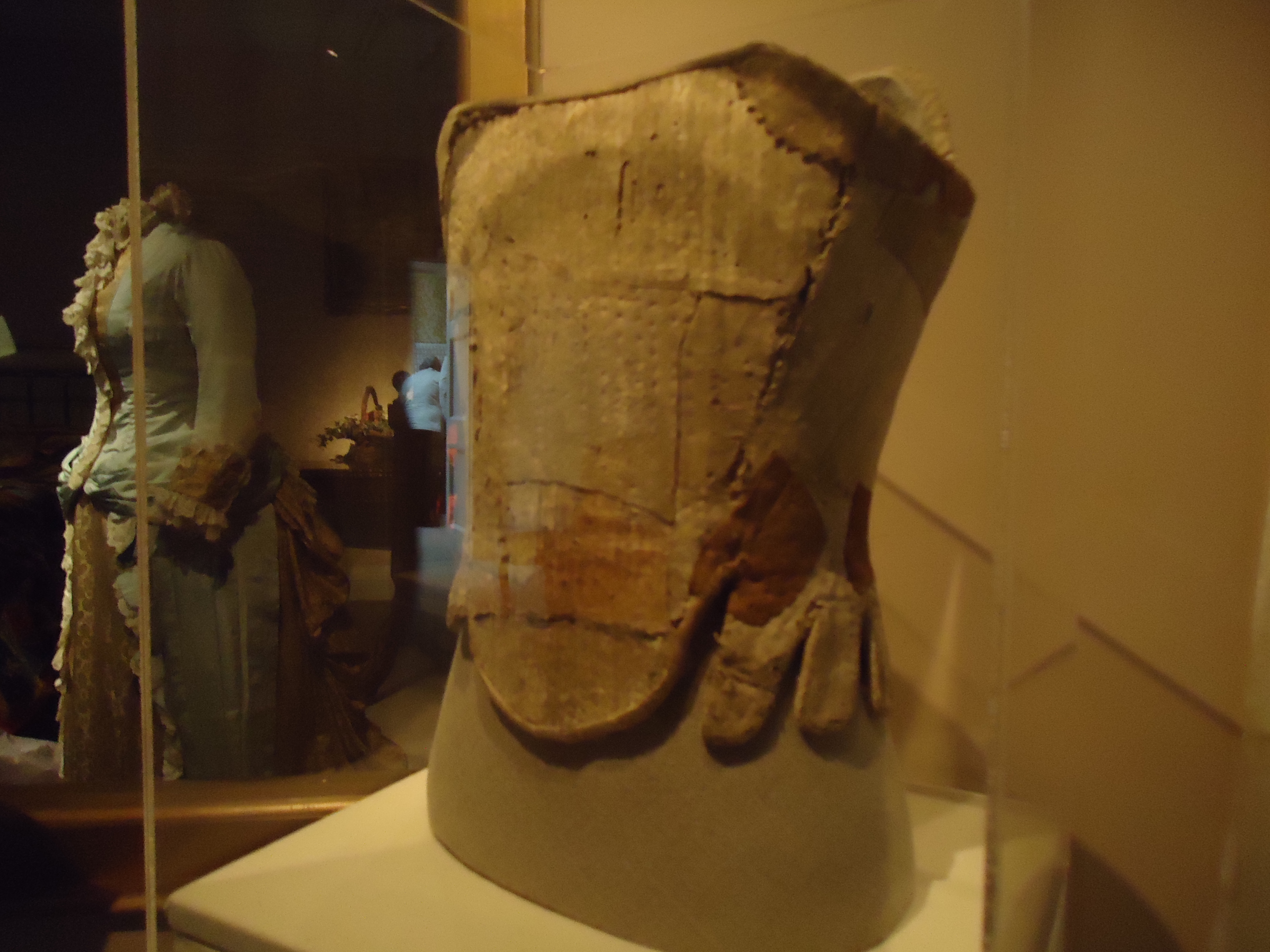 top layer that has since disappeared. The story behind these Stays was that they’d been passed down from mistress to servant. In which case, if this is true, then this is a clear example of a ‘Mistress’ having owned a pair of leather or woollen stays, that are plain in appearance. John Styles writes in his explanation of Joseph Highmore’s painting ‘Pamela’ that she recieved stays from her mistresses – admittedly they seemed to have been of a pale silk if John Styles and the image are anything to go by.
top layer that has since disappeared. The story behind these Stays was that they’d been passed down from mistress to servant. In which case, if this is true, then this is a clear example of a ‘Mistress’ having owned a pair of leather or woollen stays, that are plain in appearance. John Styles writes in his explanation of Joseph Highmore’s painting ‘Pamela’ that she recieved stays from her mistresses – admittedly they seemed to have been of a pale silk if John Styles and the image are anything to go by.
– 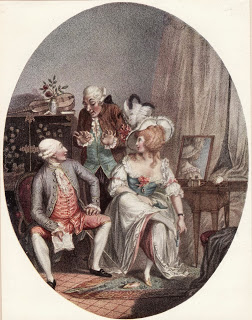 Ok, the difficulty here is there aren’t many portraits or images with the wealthy in their under garments and obviously if they are fully clothed we cannot tell what kind of stays they were wearing. The engraving opposite here is titled ‘The English Dressing Room’ – 1789 and the lady in the centre is in her stays and shift – they are white and decorated. The engraving entitled ‘The French Dressing Room’ which is of the matching pair (seen to the left now) – also has a lady in her stays and shift, and her stays are silk and blue. But these are just engravings – designed for a purpose, and that purpose may well have been the whimsical nature of women dressing – in which case, dressing
Ok, the difficulty here is there aren’t many portraits or images with the wealthy in their under garments and obviously if they are fully clothed we cannot tell what kind of stays they were wearing. The engraving opposite here is titled ‘The English Dressing Room’ – 1789 and the lady in the centre is in her stays and shift – they are white and decorated. The engraving entitled ‘The French Dressing Room’ which is of the matching pair (seen to the left now) – also has a lady in her stays and shift, and her stays are silk and blue. But these are just engravings – designed for a purpose, and that purpose may well have been the whimsical nature of women dressing – in which case, dressing
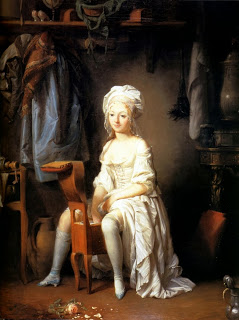 them in silky stays would far more serve the purpose of the cartoon. Most of the images of wealthy women in their stages of dressing tend to be caricatures and cartoons (see the cartoon on panniers at the very top of the page – dated 1770). All we can do is include them into this debate as examples of images of wealthy women in their stays and those stays being silky. This does not mean they never wore plain brown stays just that there are no images that paint them in
them in silky stays would far more serve the purpose of the cartoon. Most of the images of wealthy women in their stages of dressing tend to be caricatures and cartoons (see the cartoon on panniers at the very top of the page – dated 1770). All we can do is include them into this debate as examples of images of wealthy women in their stays and those stays being silky. This does not mean they never wore plain brown stays just that there are no images that paint them in
such. The following images all have the same problem. Louis Leopold Boilly’s painting seems
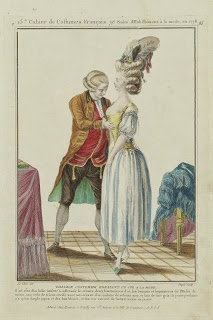 to portray a wealthily dressed lady, in blue silk stockings and with good furniture about her, in light coloured and silk looking stays ( see above). ‘The Staymaker’s Apprentice’ has the lady in yellow stays. Badouin’s ‘Effects of Reading…’ (see below) has a lady with her dress undone and light coloured stays underneath – atleast that is the assumption – they may well be a stomacher. And De Troy’s ‘Getting ready for a Masque Ball’ (see below) has the lady in rich greeny-blue looking stays with centre front lacing. –
to portray a wealthily dressed lady, in blue silk stockings and with good furniture about her, in light coloured and silk looking stays ( see above). ‘The Staymaker’s Apprentice’ has the lady in yellow stays. Badouin’s ‘Effects of Reading…’ (see below) has a lady with her dress undone and light coloured stays underneath – atleast that is the assumption – they may well be a stomacher. And De Troy’s ‘Getting ready for a Masque Ball’ (see below) has the lady in rich greeny-blue looking stays with centre front lacing. –
The ONLY image that helps our case here with plainer stays being worn for the wealthier classes is a little doll.
Now dolls could have three purposes in the 18th century. They could be made for children or for young adults as toys and ornaments, or they were samples made up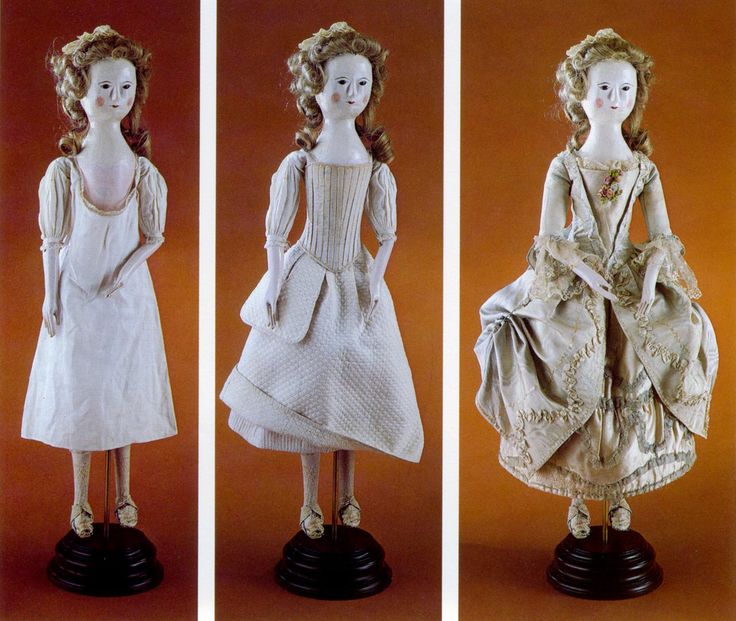 to show, in miniature, the seam-stresses skill and they were also the early version of the fashion plate, being sent from Paris to places like London so that the dressmakers for the rich could see what was in fashion and how it was made. There are two pictures here of dolls in what looks like plain linen stays. The first, showing the various layers of undergrments, is an image I have found online and have utterly no information about whatsoever! However, it is clearly an 18th century doll. And it is clearly a wonderful example of underlayers and stays – probabyl from around the 1770s – 1780s. The second d
to show, in miniature, the seam-stresses skill and they were also the early version of the fashion plate, being sent from Paris to places like London so that the dressmakers for the rich could see what was in fashion and how it was made. There are two pictures here of dolls in what looks like plain linen stays. The first, showing the various layers of undergrments, is an image I have found online and have utterly no information about whatsoever! However, it is clearly an 18th century doll. And it is clearly a wonderful example of underlayers and stays – probabyl from around the 1770s – 1780s. The second d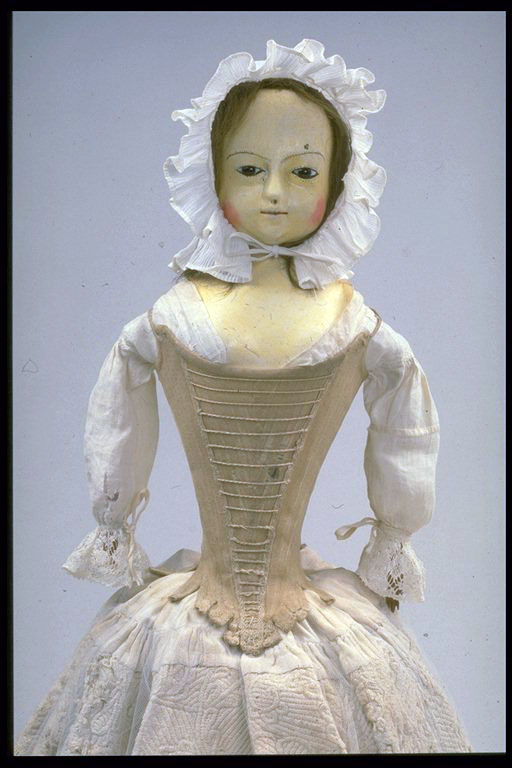 oll here wears a shift, a possible hoop, a quilted petticoat and a plain biege pair of Stays. It’s been dated 1745-55. (This image is couretsy of the museum of London)
oll here wears a shift, a possible hoop, a quilted petticoat and a plain biege pair of Stays. It’s been dated 1745-55. (This image is couretsy of the museum of London)
Now, it is unlikely that these two dolls would have been made with a plebeian audience in mind nor of a plebeian character, so its is a good example of the likelihood that this was showing a fairly fashionable lady and her fairly fashionable layers of clothing.
There are also different types of evidence we can look at. Musuem’s across the world dress these plain stays with hoops of various kinds. I realise this sounds a bit off the wall, but a lot of research goes into Musuem’s displays and they consistently research, and they consistently dress their mannequins in this way. It is not right to assume they are wrong. It’s not hard cold evidence but it is circumstantial evidence – which is still valid to a level. Hoops were much less likely to be worn by the working class – much less likely, in our eyes, than them wearing fully boned stays (and that’s not to say they didn’t). There are accounts in Mistress’s letters of their annoyance at their servants trying to mimic the hooped look by sewing various strips inside their skirts. Surely they were doing this because they didn’t have the actual hoops. Much of the silhouette they could achieve was created with quilted petticoats and possibly layers of underskirt and Beavers or Hip-pads. My reasoning is thus; for the museums to dress these plain stays with cane hoops of various sophistication, is a possible nod towards the wealthier women wearing them – ie. that it was accurate that these two items of dress would be worn together. – Another Museum-based bit of logic, is the fact that the reason why t
he Museums tend to be full of silk satin shoes and heavily embroidered court wear and wealthier 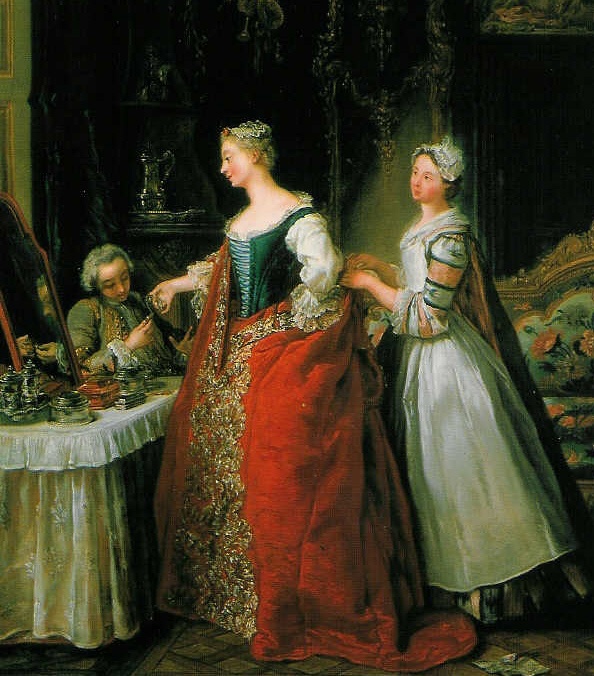 women’s dresses is that they don’t get so much wear as working peoples clothes – and aren’t subject to other demanding factors, like money. Wealthier women didn’t need to push their garments to squeeze every penny out of them. Their dresses weren’t always turned into clothing for the children and then into rags, and each individual dress got less airing due to more of a choice in the closet. Also, they had space to store keepsakes, and wealthier generations to follow that would remain keeping the garments without having to cash them in or use the fabric. If most of the other clothing that gains entry into the museums are from wealthier families why is this not the same for the stays? And why, on the whole, are they in such good condition? – Letter’s from the time that we have looked at just tend to just mention ‘Stays’ – not silk ‘Stays’ or woollen ‘Stays’ but just ‘Stays’. In Georgiana Cavendish’s novel ‘The Sylph’, for example, she mentions the pinching of stays and the broadness of the curve at the front pushing into her arms, but she doesn’t mention the fabric. However, Mrs Delaney does mention in her autobiography that ‘The Stays were white silk…” but from all the excerpts we’ve looked at that’s the only one that mentions fabric. – The wonderful Barbara Johnson never mentions fabric for her Stays, in all of her lifetime’s collection of keeping a swatch of fabric from the various dresses she had made up for her (see Barbara Johnson’s Album of Fashion and Fabrics) not once does she include any for stays. Which is kind of interesting.
women’s dresses is that they don’t get so much wear as working peoples clothes – and aren’t subject to other demanding factors, like money. Wealthier women didn’t need to push their garments to squeeze every penny out of them. Their dresses weren’t always turned into clothing for the children and then into rags, and each individual dress got less airing due to more of a choice in the closet. Also, they had space to store keepsakes, and wealthier generations to follow that would remain keeping the garments without having to cash them in or use the fabric. If most of the other clothing that gains entry into the museums are from wealthier families why is this not the same for the stays? And why, on the whole, are they in such good condition? – Letter’s from the time that we have looked at just tend to just mention ‘Stays’ – not silk ‘Stays’ or woollen ‘Stays’ but just ‘Stays’. In Georgiana Cavendish’s novel ‘The Sylph’, for example, she mentions the pinching of stays and the broadness of the curve at the front pushing into her arms, but she doesn’t mention the fabric. However, Mrs Delaney does mention in her autobiography that ‘The Stays were white silk…” but from all the excerpts we’ve looked at that’s the only one that mentions fabric. – The wonderful Barbara Johnson never mentions fabric for her Stays, in all of her lifetime’s collection of keeping a swatch of fabric from the various dresses she had made up for her (see Barbara Johnson’s Album of Fashion and Fabrics) not once does she include any for stays. Which is kind of interesting.
For now, and I mean this most solemnly, we will have to leave proving that the Middling Sort and Upper Classes wore our particular type of Stays, as I have used up all my evidence. It’s got to be pointed out that 100% of the images when showing wealthier ladies in their undergarments – all show them in lighter colours, or blues, or with decorations. N
one yet have shown plain brown pair of stays apart from the doll.
Next we will be discussing Images and evidence of Poorer Women NOT wearing Stays – please click on the link here or go to our Research Page.

